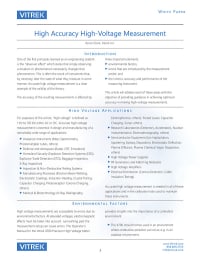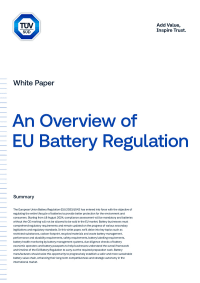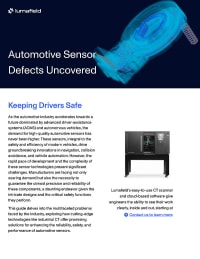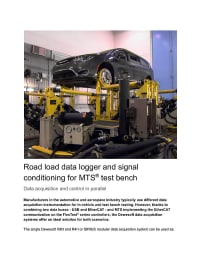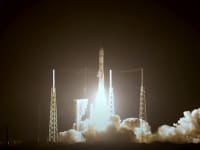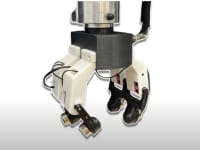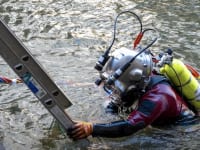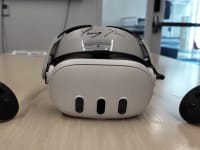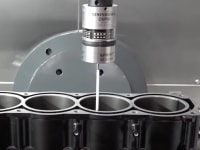Briefs: Medical
A study conducted by Fuyang Yu and his colleagues introduces an innovative approach to lower limb rehabilitation. Their research outlines the development of a lower limb rehabilitation robot designed to significantly improve the safety and effectiveness of gait training through a novel method based on human-robot interaction force measurement. Read on to learn more.
Briefs: Sensors/Data Acquisition
This lightweight, portable garment is designed for active shoulder and elbow positioning.
Briefs: Sensors/Data Acquisition
Researchers at Fuzhou University in China created a machine vision sensor that uses quantum dots to adapt to extreme changes in light far faster than the human eye can — in about 40 seconds — by mimicking eyes’ key behaviors. Their results could be a game changer for robotic vision and autonomous vehicle safety. Read on to learn more.
Briefs: Sensors/Data Acquisition
New smart sensors can help detect dangerous internal failures in lithium-ion batteries before they escalate into fires or explosions, say researchers from the University of Surrey. Read on to learn more.
Briefs: Robotics, Automation & Control
A team of engineers has developed a low-cost, durable, highly-sensitive robotic ‘skin’ that can be added to robotic hands like a glove, enabling robots to detect information about their surroundings in a way that’s similar to humans. Read on to learn more.
Briefs: Information Technology
Northwestern engineers have developed a new system for full-body motion capture — and it doesn’t require specialized rooms, expensive equipment, bulky cameras, or an array of sensors. Instead, it requires a simple mobile device. Read on to learn more.
Briefs: Unmanned Systems
Forest fire prevention and control agencies in São Carlos, in the interior of the state of São Paulo, Brazil, will soon have help from the sky to detect fires more quickly and combat them before they grow out of control, as researchers at the University of São Paulo are developing drones equipped with gas sensors and artificial intelligence systems to detect forest fires.
Briefs: Unmanned Systems
Researchers from the College of Engineering and Computer Science at Florida Atlantic University have proposed a design for an alternative, autonomous observational method, which holds promise for improving the autonomy of marine vehicles, aiding in maritime missions, and gaining a deeper understanding of how melting Arctic sea ice affects marine ecosystems. Read on to learn more.
Briefs: Imaging
Maksym Kovalenko and his team have proposed a novel solution that allows them to utilize every photon of light for color recognition. For nearly a decade, they have been researching perovskite-based image sensors. In a new study published in Nature, they show that their new technology works. Read on to learn more.
Briefs: Materials
KAUST researchers have invented a robust, highly sensitive, low-cost hydrogen sensor that outperforms available commercial detectors, offering a vital safeguard for the burgeoning hydrogen economy. Read on to learn more.
Briefs: Sensors/Data Acquisition
Plans are underway to create more powerful particle accelerators, whose collisions will unleash large subatomic storms. How will researchers sift through the chaos? Read on to find out.
Briefs: Imaging
A team of researchers from Tokyo Tech, led by Associate Professor Yukio Kawano, has designed a flexible and free-standing THz sensor array that can be used to image blind ends of irregularly shaped objects. Read on to learn more about it.
Briefs: Sensors/Data Acquisition
Known as FOSS (for fiber optic sensing system), NASA’s technology portfolio combines advanced sensors and innovative algorithms into a robust package that accurately and cost-effectively monitors a host of critical parameters in real time. Read on to learn more.
Briefs: Wearables
A team of Caltech engineers has developed a technique for inkjet printing arrays of special nanoparticles that enables the mass production of long-lasting wearable sweat sensors. These sensors could be used to monitor a variety of biomarkers, such as vitamins, hormones, metabolites, and medications, in real time. Read on to learn more.
Briefs: Wearables
A research team from Japan has fabricated a flexible multimodal wearable sensor patch and developed edge computing software that is capable of detecting arrhythmia, coughs, and falls in volunteers. Read on to learn more about the sensor, which uses a smartphone as the edge computing device.
Briefs: Materials
Engineers at MIT, Nanyang Technological University, and several companies have developed a compact and inexpensive technology for detecting and measuring lead concentrations in water, potentially enabling a significant advance in tackling this persistent global health issue. Read on to learn more.
Briefs: Energy
Buildings are big energy consumers, emitting wasteful carbon, contributing to a warming planet, and accounting for more than 40 percent of the world’s carbon dioxide emissions. Fortunately, a new startup is paving the way for dramatic reductions in carbon from building operations. Lamarr. AI has perfected the process of using drones, thermal imaging, and artificial intelligence (AI) to diagnose the health of building exteriors and roofs. Read on to learn more.
Briefs: Photonics/Optics
Engineers at the University of California San Diego have achieved a long-sought milestone in photonics: creating tiny optical devices that are both highly sensitive and durable — two qualities that have long been considered fundamentally incompatible. Read on to learn more.
Briefs: Sensors/Data Acquisition
Researchers have developed an on-chip twisted moiré photonic crystal sensor that uses MEMS technology to control the gap and angle between the crystal layers in real time. The sensor can detect and collect detailed polarization and wavelength information simultaneously. Read on to learn more.
Briefs: Lighting Technology
Engineers at NASA Langley Research Center have developed a cutting-edge thermal inspection technology that enhances defect detection on low-emissivity surfaces by eliminating false readings caused by infrared reflections. Read on to learn more.
Briefs: Wearables
Virtual reality video games that combine screen time with exercise are a great way to get fit, but game designers face a major challenge — adherence to ‘exergames’ is low, with most users dropping out once they start to feel uncomfortable or bored. Read on to learn what a team did to thwart this.
Briefs: Test & Measurement
Innovators at NASA Johnson Space Center have developed a thin film sensor that measures temperatures up to 1200 °F, and whose prototype successor may achieve measurements up to ~3000 °F — which was the surface temperature of the Space Shuttle during its atmospheric reentry. Read on to learn more.
Briefs: AR/AI
Researchers from Duke University have developed a novel framework named WildFusion that fuses vision, vibration, and touch to enable robots to “sense” complex outdoor environments much like humans do. Read on to learn more.
Briefs: Software
A human clearing junk out of an attic can often guess the contents of a box simply by picking it up and giving it a shake, without the need to see what’s inside. Researchers from MIT, Amazon Robotics, and the University of British Columbia have taught robots to do something similar. Read on to learn more.
Briefs: Test & Measurement
A spacecraft power system that combines the technological know-how of engineers and scientists at the University of Leicester and NASA Glenn has passed its first test with flying colors. Read on to learn more about it.
Briefs: Sensors/Data Acquisition
Researchers developed wearable skin sensors that can detect what’s in a person’s sweat. Using the sensors, monitoring perspiration could bypass the need for more invasive procedures like blood draws and provide real-time updates on health problems such as dehydration or fatigue. Read on to learn more.
Briefs: Nanotechnology
Researchers have developed a new type of sensor platform using a gold nanoparticle array. The sensor is made up of a series of gold disk-shaped nanoparticles on a glass slide. When an infrared laser is pointed at a precise arrangement of the particles, they start to emit unusual amounts of ultraviolet light. Read on to learn more.
Briefs: Unmanned Systems
Researchers have created a 98-milligram sensor system — about one tenth the weight of a jellybean or less than one-hundredth of an ounce — that can ride aboard a small drone or an insect, such as a moth, until it gets to its destination. Then, when a researcher sends a Bluetooth command, the sensor is released from its perch and can fall up to 72 feet — from about the sixth floor of a building — and land without breaking. Once on the ground, the sensor can collect data, such as temperature or humidity, for almost three years.
Briefs: Sensors/Data Acquisition
These materials can detect when they are damaged, take the necessary steps to temporarily heal themselves, and then resume work.





